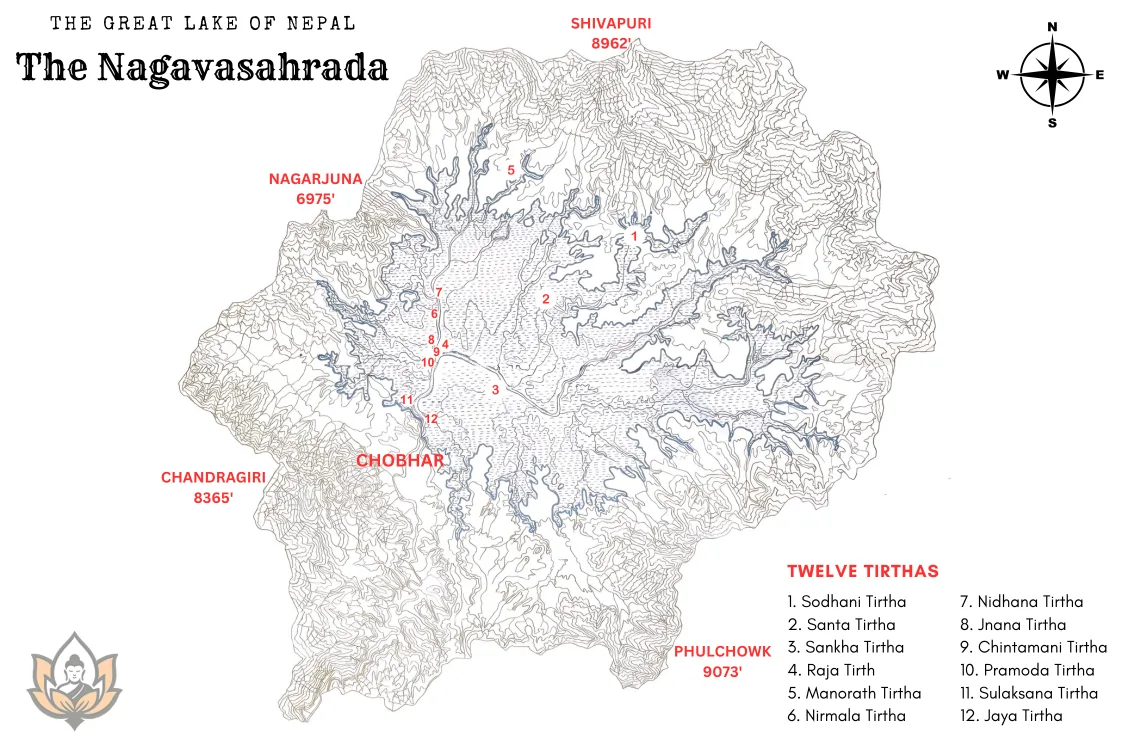A Pristine Paradise: Great Lake of Nepal
In the Golden Age, or Satya Yuga, the present Valley of Nepal was a magnificent lake, measuring 7 Kosa by 7 Kosa (14 miles by 14 miles; 1 Kosa ~ 2 Miles), also known as SaptaKosa – सप्तकोश, surrounded by towering mountains and lush forests. It was a time when human life lasted for 80,000 years (Satya Yuga – सत्य युग), providing humans the freedom to seek knowledge. This lake, known as Taodhanahrada – तौधनह्रद (Great Lake), was fed by countless springs and streams and boasted crystal-clear, deep blue waters. It was also referred to as Kalihrada – कालीह्रद due to its profound depths that made the water appear an almost blackish-blue. So beautiful was this lake that it was often compared to the sacred Mansarovar Lake.
The water of Taodhanahrada was renowned for its exceptional qualities. It was pure, fragrant, cool, tasty, light, smooth, pleasant, and wholesome. This divine body of water served as a holy site for Buddhas, Bodhisattvas, and Nagarajas. The lake’s sovereign, Karkotaka Nagaraja (कक्र्कोदक नागराज), was revered, and the lake itself became known as Nagarasahrada – नागरसरह्रद (Lake Kingdom of Nagas). This sacred lake was a spiritual hub where divine beings gathered to pay homage.

The Arrival of Vipaswi Tathagata
During this era, in the city of Bandhumati Nagara, believed to be the region of present-day Bungamati, south of Kathmandu, lived Vipaswi Tathagata (also spelled as Vipassi Tathagata), in Sanskrit विपस्वी तथागत, the first in the lineage of Buddhas. The term Tathagata, meaning “as they come in the same way they go,” signifies a being who can enter and leave human existence at will. Among his disciples was Dharma Satya, destined to be reborn in a later age as Sakyamuni Buddha.
Hearing of the sacred lake Taodhanahrada, Vipaswi Tathagata embarked on a pilgrimage to this holy site, accompanied by his disciples. Upon arrival, he took a ritual bath in the lake’s pure waters and immediately sensed its profound sanctity. The breathtaking beauty of the surroundings and the lake’s spiritual essence inspired him. As he circled the lake, he noticed every type of flower in its waters except for the lotus.
The Prophetic Lotus of Light
Standing atop the mountain to the northwest, known today as Nagarjuna Mountain, near Swayambhu Hill, Vipaswi Tathagata took a lotus root, chanted a sacred mantra over it, and cast it into the center of the lake. Turning to his disciples, he made a remarkable prophecy:
“In the future, this root will bloom into a lotus flower with a thousand petals. Atop this lotus will manifest the light of Swayambhu Dharmadhatu, self-created and eternal. Where this lotus blooms, a small hill will arise.”
He foretold that this hill, less than 300 feet above the valley floor, would bear different names across the ages:
- In Satya Yuga – सत्य युग: It will be called Padmagiri – पद्मगिरी (Lotus Hill).
- In Treta Yuga – त्रेता युग: It will be known as Vajrakuta Parvata – वज्रकुट पर्वत (Diamond Hill), symbolizing the Dharmadhatu and the Vajrayana school of Buddhism practiced in Nepal.
- In Dwapara Yuga – द्वापर युग: It will take the name Gosring Parvata – गोशृंग पर्वत (Horn of the Cow), as the two hills of Swayambhu and Manjushri resemble a cow’s horns.
- In Kali Yuga – कली युग: It will be referred to as Gopuccha Parvata – गोपुच्छ पर्वत (Tail of the Cow), as the Manjushri Hill, slightly lower in elevation, forms the “tail” of the higher peak.
This site, Vipaswi declared, would become a place of pilgrimage for all Buddhas, Bodhisattvas, and seekers of enlightenment.
A Vision Fulfilled
Having completed his pilgrimage and delivered his prophecy, Vipaswi Tathagata and his disciples paid homage to the holy lake one final time before returning to their homeland. This sacred prophecy laid the foundation for the spiritual significance of the valley, foretelling its transformation into a hub of enlightenment and divine energy.
Swayambhu Purana – Table of Contents
« Chapter 1: Swayambhu Purana: Introduction
Chapter 3: Sikhi Tathagata: Worshipping Swayambhu »

